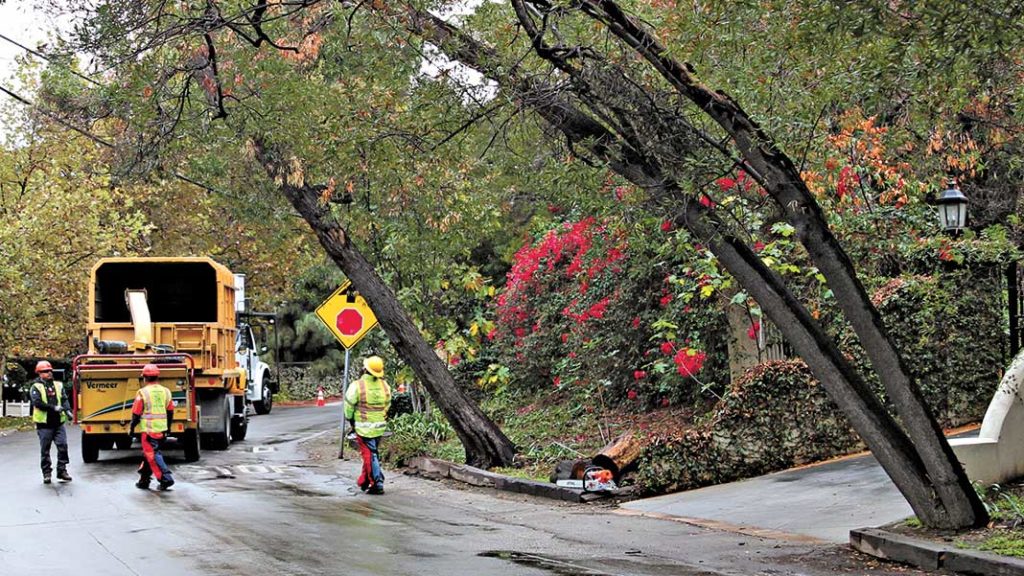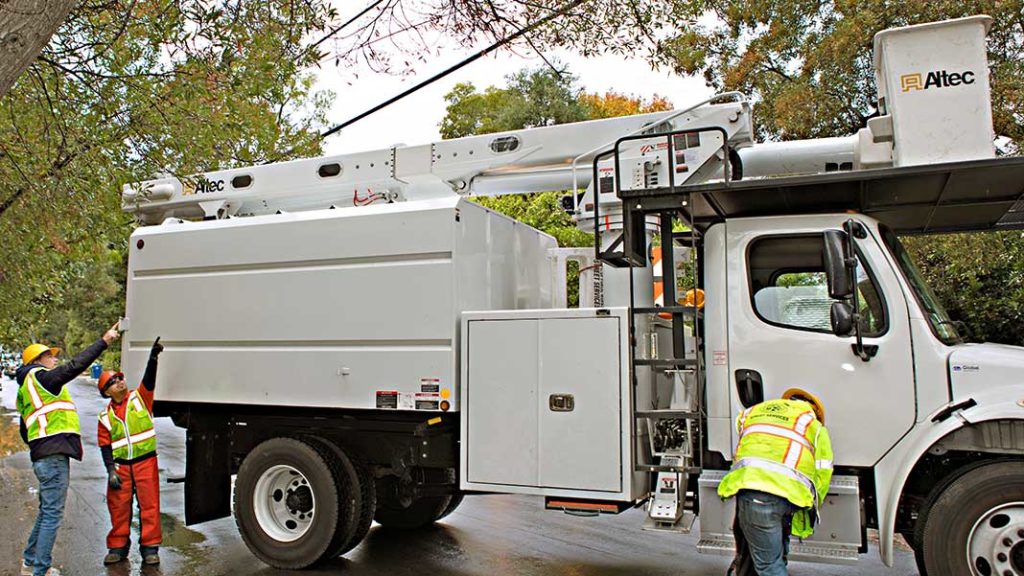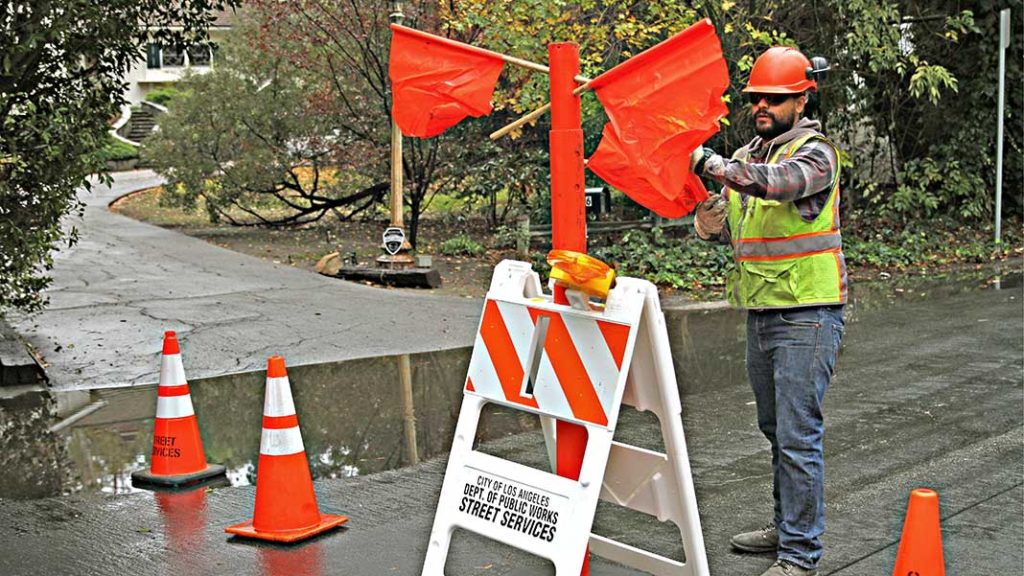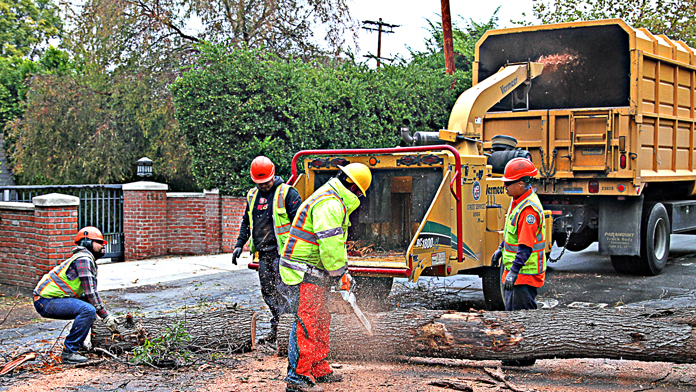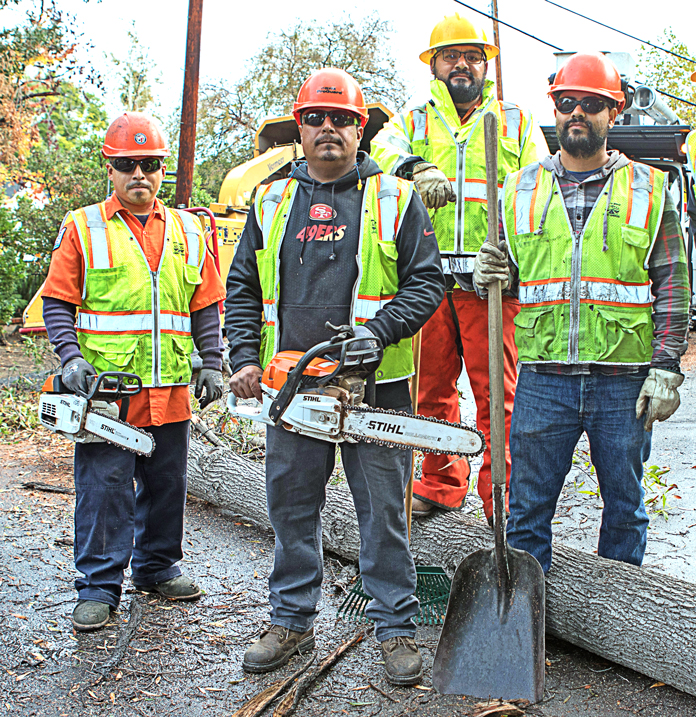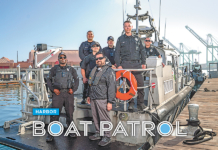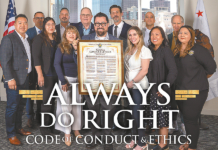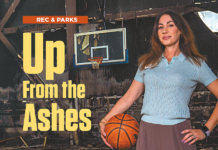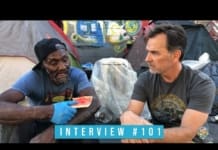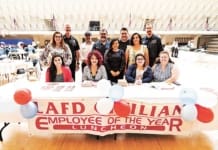Photos by Summy Lam, Club Director of Marketing; and Alive! editor John Burnes
Come along as the Club follows the emergency crew trimming trees during a December rainstorm.
In early December, the Alive! crew visited with Urban Forestry’s West Valley Area as it responded to the aftermath of a two-day rainstorm. West Valley receives 10,000 calls each year for fallen trees, obstructing trees, and other situations – about 40 per day.
History
What is now known as the Urban Forestry Division (UFD) began its existence in 1930, when the Division of Forestry of the Department of Parks was created by City Ordinance.
The City of Los Angeles 1932 Olympics ushered in a period of mass tree planting. From 1933 to 1935, approximately 12,000 trees were pruned. During this period State Gas Tax funds were provided for tree work on major streets and state highways and the first two regularly employed tree trimming crews were hired.
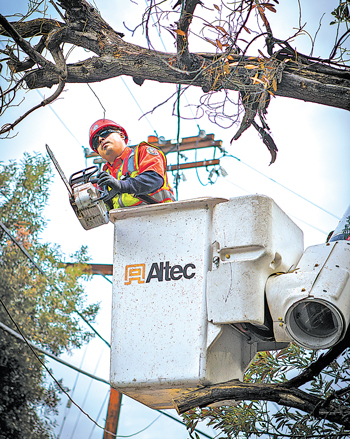
In 1940, a policy of trimming trees to provide clearance for public utilities was adopted by the Board of Park Commissioners. In 1955, jurisdiction over street trees was transferred to the Board of Public Works. The Street Tree Division was created and the organization became largely what exists today.
Post-World War II, the street tree population experienced a very large expansion due to the population and commensurate building boom that was occurring. From 1946-70, the street tree population grew from perhaps 300,000 trees to approximately 680,000. The Street Tree Division grew coincidentally to the maintenance needs, and by the mid-1980s employed nearly 300 personnel.
The Street Tree Division changed its name to the Urban Forestry Division in 2004 due to the expansion of services the Division provides that includes: street tree emergency response, pruning, removal, planting, permitting, providing arboriculture knowledge to other City agencies, oversight of the City’s protected trees, and development services.
Due to the City’s financial crisis beginning in 2009 and continuing today, the Division staffing was reduced to approximately 100 personnel. The Division continues to provide emergency services but tree trimming, removal, and planting have been severely reduced. The Division is hopeful the City soon rebounds from these difficult times and an increase in services can occur.
Timothy Tyson, Club Member, is the Division Manager of Public Works’ Street Maintenance/Urban Forestry Division Manager.
The Alive! Interview
On Dec. 5, Club CEO John Hawkins interviewed Scott Harmon, Tree Surgeon Supervisor II, 22 years of City service, Club Member, at the Urban Forestry West Valley headquarters in Canoga Park.
Scroll up and down in the box below to read the entire interview:
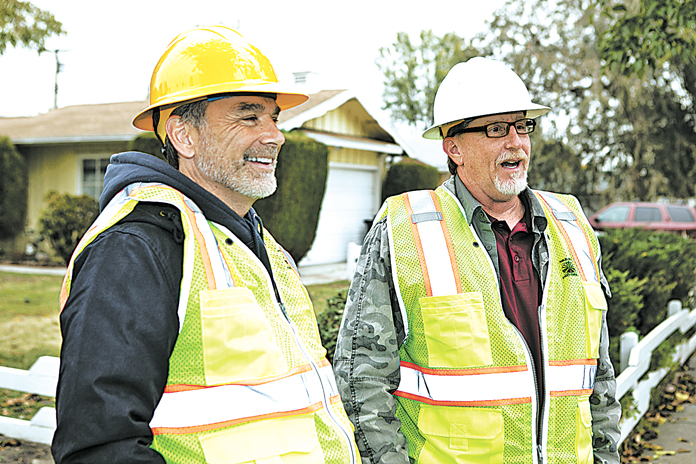
Passionate About Trees
Scott, thanks for letting us follow you as you managed trees during the storm this morning. First, tell us how you got to your current position.
Scott Harmon: Sure. I started at the bottom with the City. I was a contractor before I came here. I had experience, but I have six kids. So, the City was a good opportunity for me. I started at the bottom. I took a Tree Surgeon Assistant position, got promoted pretty quickly because I had experience.
Did you do tree work before you came here?
I did. I was doing tree illumination.
Really?
Yes, but it was very specialty lighting. It was the stuff you see at really high-end hotels – most likely nobody in this room could afford these kinds of lights. I’d fly to Hawaii to do jobs. I’d fly to Florida. I’ve been all over the country.
Wow.
I was into trees so much I just did the whole arborist thing, and I was trimming the trees while we were doing the lighting.
I kept my business for 20 years, even while I was here. I ran the program crew here for almost 10 years and I was on the superintendent’s list, but downtown’s just not for me. There are not enough windows.
Nor trees.
Nor trees. And I’m still a tree guy until I’m too broken to work.
This is the West Valley Area. How many are there?
We have four areas. Actually, we have five. Street maintenance has four.
What are the areas?
West Valley, East Valley, North Central over by Griffith Park, Bay Harbor down by LAX, and a fifth area, because we can’t cover what is called the Mountain Area. So, it’s a sort of weird– part of East Valley and part of West Valley, which is split by the 405. That’s our boundary line. South of Mulholland down to Pico is its own little area. So, I’m still sort of over that part, all the way down to Pico. And the guy in the East Valley’s sort of over his part. But we do have one yard there with one supervisor and one small crew, because we just can’t get there from here.
How is it different now than when you came?
We had a lot of people when I came in ’96 and the work was nonstop. It was great. It was trimming and removals and stump grinding. We didn’t do the stump grinding, but it was being done. All the services that people wish we had, they were being served. But in 2010, the City stopped that.
Because of the national economy crunch.
Right. Equipment has changed since I started. The chippers have definitely changed. We never had over-the-cab loaders, which is a truck with a scoop on the front, so you just roll everything into and then just throw it in the back. We never had them in ’96. We had loaders, but nothing like what you saw today.
Has anybody ever estimate how many trees you have in your area?
In this area, I couldn’t tell you exactly, but Citywide it’s about 680,000.
Wow.
Yes.
And that doesn’t count private trees – that’s just street trees.
Yes, what we call parkway trees. Along streets.
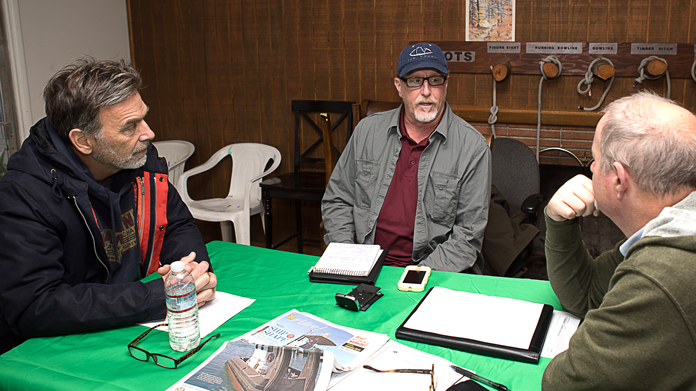 How many calls do you get in a year, and how does that rank with the five areas?
How many calls do you get in a year, and how does that rank with the five areas?
Over the last two fiscal and calendar years, West Valley has averaged about 20,000 to 21,000 calls. That’s over two years. So, more than 10,000 calls a year, on average.
How many a day is that?
Comes to about 41 calls a day.
Man!
That doesn’t include the regular trimming crew. That’s Carmelo Hernandez’s crew, whom you met later in the morning today. Carmelo reports to someone else. They’re normally out grid-trimming, but we knew we had some emergency things to look at today, so we asked them to come help out.
So the 40 a day is just for the emergency response crew?
Right. They stage their equipment here, but they don’t report directly to me, except for emergencies. We’re an emergency response crew, and this office also handles all the permits, all the protected tree reports, and all the sidewalk repair requests. The sidewalk repairs wouldn’t be included in that number, and neither would the Council District requests. But as far as staff goes, I have enough only to do the emergencies.
And that’s how many staff?
We have nine total.
You receive the most calls of any of the five areas?
The West Valley is the highest.
When this area was developing commercially – and there is a lot of real estate development out – they planted the bigger, fast-growing shade trees because everything was so hot. In the LA basin, they don’t have the liquid amber trees, or sweet gum trees, that are actually a back east tree. They grow to 70- to 80-feet tall and then break. We have thousands of them. We have mulberries because they wanted that fast-growing shade tree, and they were all planted at the same time. They’re all starting to die at the same time or have been dying for a while. We have a backlog of 4,500 dead trees here in the West Valley.
No wonder you’re so busy.
Right.
And we do a lot of protected tree reports, too – the old trees, the sycamore trees– for construction, because they’re protected by the state and the county, and we have a really strict ordinance.
So, they can’t be moved or cut down for development.
Right.
We protect two oak trees: the valley oak the coast live oak; the California Bay laurel; and the Western black walnut. And the sycamore.
I’ve probably done more protected tree reports for our division than anybody. Most of the tree reports are for over in that Mulholland area – Brentwood, the Palisades, West LA, and Bel Air. When I worked there for five years I did all the reports. And then, because I was doing so many reports, they gave me all the other ones, the outliers. Before that, I was the arborist for the sidewalk program. So, I really am passionate about protecting those trees. Most of the contractors don’t like me. “Oh, man, not Scott.” They literally hope I am not the guy. But if they do it right, they can have what they want.
The oaks tend to be big.
The oaks are big. And they take hundreds of years to grow, so when contractors do something that harms them, it takes 50 years to die. That’s why we have to be really careful now. You don’t know it’s going to die and then later another generation’s not going to have what they need.
Trending in Trees
What’s trending in trees? What are you seeing a lot of now?
I’m trying to establish the right tree in the right place. That’s the motto for the whole division. I’m trying to get away from the pigmy species, which are the Crape Myrtles and the small flowering trees. They’re super pretty, but they do nothing for what we really need the trees for – to shade the asphalt. We don’t have the funding for that, so we have to rely on outside sources.
I just wrote a proposal, and I’m hoping to present it by the end of the calendar year, to restructure how we deal with private property trees. A lot of our work is private property trees falling into the public right-of-way. If it’s blocking the right-of-way, we clear it. And the homeowner gets a freebie. I’m not saying we shouldn’t do that, because we’ve always done that, but we don’t have the staff. I’m trying to restructure how we deal with the public trees, to where it would self-fund by using reclaimed water for watering. We have several reclamation plants that could supply the water. There’s no reason we can’t water trees with reclaimed water.
And the trees that we’re planting now should also be drought-tolerant. Part of the problem we have with all these 4,500 dead trees is that they weren’t getting any water. We used to have orange trees in the Valley because there was a high water table. But it’s all gone. And it will never fill up, because once they drain, they collapse.
You talked about the right tree in the right place. What trees are you choosing from?
We have a list of 150 trees, but it’s based on how wide’s the parkway. Some places we have a three-foot parkway. But if you go up on White Hook, for example, it’s an 18-foot wide parkway. You have to pick a tree specific for the site.
One of the really cool things that we’re doing now– not too many people are talking about it – is uniform plantings. Say they used mulberries on this side and mulberries on this side. That was the common practice. Then the next street over would be a different species. They were smart enough to change it, because if you got a disease or a pest that killed these, you’re going to get that disease. But now we’re actually changing it on opposite sides of the street, not just on every other street. Opposite sides of the same street. It’s the same principle. If something kills these, at least you still have those.
We’re trying to do that. We’re relying grant money and nonprofits to do all the planting. We don’t have any planting in our division.
But anyway, the innovation right now is green, green, green, and reclaimed water and the mulch and all that.
What kind of trees should City residents be planting?
That would be site specific, but you want trees that don’t have invasive root systems most of the time, whether it’s a front yard tree or a parkway tree. Your sewer line is going to be out there somewhere. And if you haven’t replaced it with the new ABS pipes, you still have the old clay pipes, those are all broken where they put them together, and the roots will definitely go in there. Also, use a deciduous species, which means it drops its leaves in the fall. It will help heat your house when it drops its leaves. It helps shade your house when it’s full-shade in the summer. But if you don’t need that, I prefer evergreen trees, because they have leaves all year long – or they lose their foliage all year long, you just don’t notice it. And that will help clean the air more, because the leaves do the filtering.
Is there a favorite tree that you have that you like to see when you’re driving around on the parkways?
I like Jacarandas. Those are the ones with the big purple flowers.
Yeah, those are cool.
They’re really great trees. They do require a lot of maintenance. And that’s the other thing: Low maintenance trees would be a recommendation to people who aren’t in the business, because they have a problem trimming them themselves.
Good Crew
Do you have a good crew?
I have an amazing crew. You have to work hard in the tree business. My crew goes above and beyond, every single day. My guys average about four to five calls per person per day. It’s a special person who comes out to the West Valley and works. Some of them are here because they have to – they have no choice, because this is where they were assigned and they just can’t get out, because nobody will trade with them.
We work really hard to be a team. You don’t see any true individuals in this yard. Everybody’s working together.
Why do you love what you do?
That’s a good question. I get to help a lot of people.
Why do you love trees?
They’re absolutely amazing. Trees are so resilient. They do so much for us. I don’t think people realize every day how much they filter the air. They actually catch the carbon from the air and they hold it in the wood.
Not too many people can do this job. It’s sort of like when we’re 80-foot up in the air in the tree and we look out, we’re seeing something that you’re never going to get to see. It feels different.
You sort of have to be a little weird to do this job – hang from a rope with a chainsaw two feet from your face, cutting trees. And it’s exciting. Of course we’re always safety-conscious. Always. You saw that in our safety meeting this morning.
I think trees are beautiful. It’s a beautiful job. But I get to help a lot of people. I get to help my constituents, my employees, the Council office, and my bosses.

From left: Club CEO John Hawkins and Tree Surgeon Supervisor II Scott Harmon, Club Member.
What do you wish people knew about what you do?
That we are professionals, that we take it seriously and we know what we’re doing. We talk to tons of amateur arborists on the phone every single day: “Well, my neighbor said–”; “my gardener said–”; “my gardener this–“; “my gardener that –” Oh? Hire your gardener to do your report for you and submit it and we’ll evaluate it! We work really hard to do the right thing for the trees. We save a lot of trees that people want removed. We remove a lot of trees that people want saved. People might not always like what we do. But it’s all about doing the right thing for the tree in the community.
I just love trees. Plant more trees. Water your trees – but use “slow water.” Don’t use a sprinkler. Just take the hose out, put it on very slow, and leave it for 12 hours.
Here’s one other thing: I’m really proud of this, and this just happened this year. I am the only municipal specialist in the division. It came from the International Society of Arboriculture, which licenses tree professionals. To be a supervisor, you have to be a certified arborist. That’s one of the lower levels. Then there’s tree risk assessment qualified, which is higher, and then there’s municipal specialist. I’m the only one in the division that has all three. The only thing higher is a registered consulting arborist, which is what people on the outside use to make money writing reports for the City.
There’s no one in our division that’s an RCA. I’m proud of that. Having said that, though, I’m still hoping you focus on my crew! They deserve the attention, not me. My crew is more important.
You got it. Thank you for letting us come in after your crew and see how you do what you do.
Thank you, guys. It was really fun.
In the Field With the Tree Crews
On Dec. 5, in a respite during a two-day rainstorm, Alive! caught up with the West Valley Area tree crews on emergency and trimming assignments.
Encino: Tree and Wires
An emergency call came in that two trees were in danger of pulling down communication wires on X Street in Encino. When Alive! caught up to the emergency crew, they were just about to take down the first tree.
1] Two trees (center and center-left) were threatening communication wires and had to come down.
2] Carlos Leon, Tree Surgeon (Leadman), in the red safety cap, explains the tree/wire problem to Club CEO John Hawkins (left).
3] First things first: Safety. Samuel Mendoza, Assistant Tree Surgeon, sets up a cone zone to protect the tree crew from traffic.
4] Seeing that the first tree will not bring down the wires when it falls, the tree surgery begins: Jonathan Suarez, Tree Surgeon II chain-saws into the acacia.
5] Timber!

6] Once it’s on the ground, Jonathan Suarez sections and trims the fallen tree so it can be mulched in the chipper.
7] Thank you very mulch: As the tree is sawed apart, it’s placed in the chipper for immediate mulching. Doing the honors are (from left) Samuel Mendoza, Assistant Tree Surgeon; Joaquin Lopez, Tree Surgeon; and Carlos Leon, Tree Surgeon (Leadman). Jonathan Suarez continues sawing.

8] Into the chipper it goes.
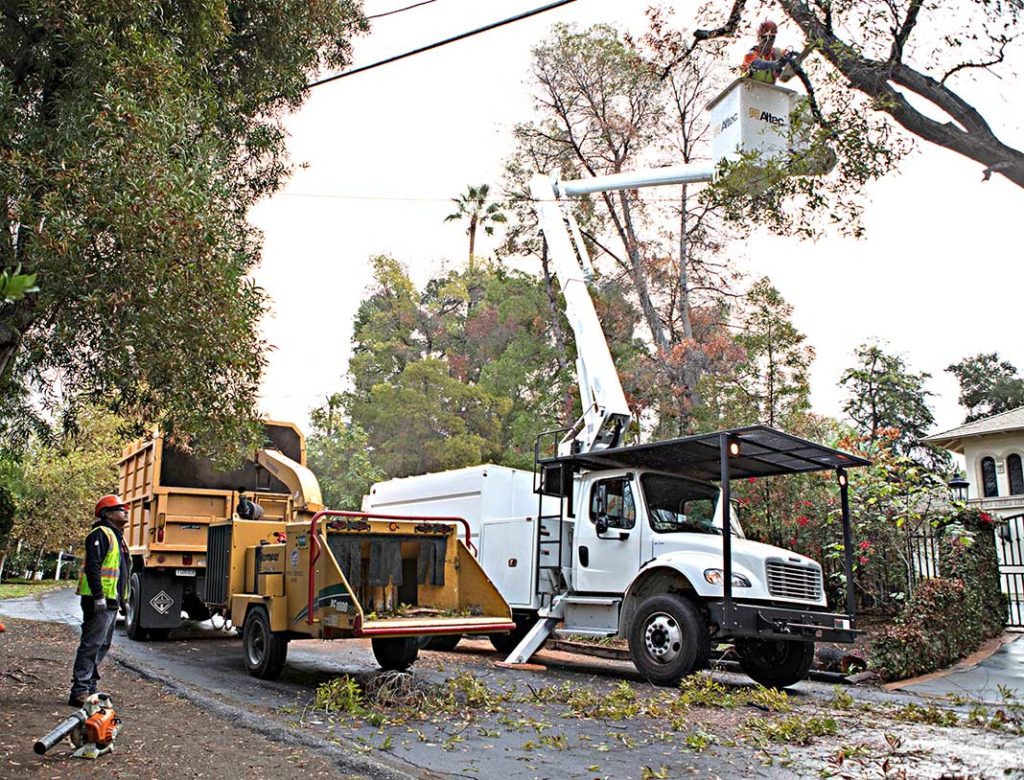
9] The removal of the second tree is more complicated: The tree has to be trimmed in the air before it’s brought down, to make sure it doesn’t bring the communication wires down with it. This calls for the bucket. High in the air, Carlos Leon, Tree Surgeon (Leadman) expertly trims the tree to eliminate the risk.

10] After all is chopped and mulched, cleanup is the final step. The crew tidies up every site before every job is done.
11] A job well done: Club CEO John Hawkins (right) with (from left) Carlos Leon, Tree Surgeon (Leadman); Juaquin Lopez, Tree Surgeon; Jonathan Suarez, Tree Surgeon II; and Samuel Mendoza, Assistant Tree Surgeon.
Canoga Park: Regular Tree Trimming
Next, the Alive! crew caught up with a second crew on West Gilmore Street in Canoga Park, this crew doing its normal operation of tree-trimming. The crew will take one street at a time and trim trees that need it all along the block before moving on.
1] The tree-trimming crew and supervisors, from left: Miguel Barajas, Tree Surgeon, 1 year of City service; Elias Becerra, Heavy Duty Truck Operator, 2 years; Carmelo Hernandez, Tree Surgeon Supervisor 1, 27 years; Scott Harmon, Tree Surgeon Supervisor II, 22 years, Club Member; Jorge Jimenez, Tree Surgeon, 2 years; Richard Mitchell, Maintenance Laborer, 2 years; Juan Velasco, Tree Surgeon, 2 years; and Samuel Mendoza, Assistant Tree Surgeon, 1 year. In back outside the cab: Ronny Wong, Heavy Equipment Operator, 16 years.

2] Due to the height of the trees on West Gilmore Street, the crews use the lifter to help them trim.

3] The inevitable cleanup begins, assisted by Ronny Wong, Heavy Equipment Operator, a magician at the front loader.
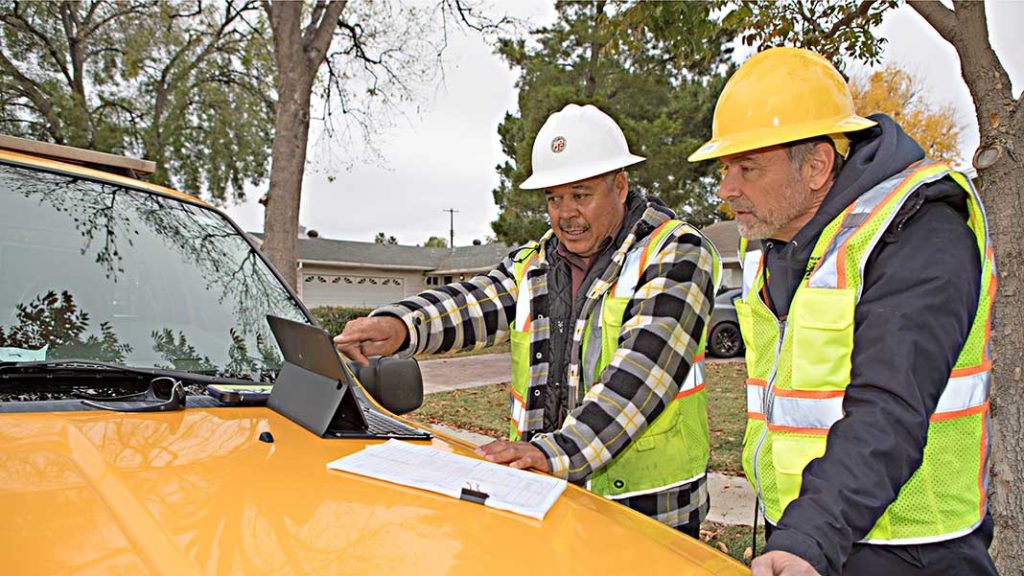
4] Communication is key: Urban Forestry operations can be managed through mobile devices to save time and be more efficient and responsive. Here, Carmelo Hernandez, Tree Surgeon Supervisor in charge of the tree-trimming crew, shows how it works to Club CEO John Hawkins.
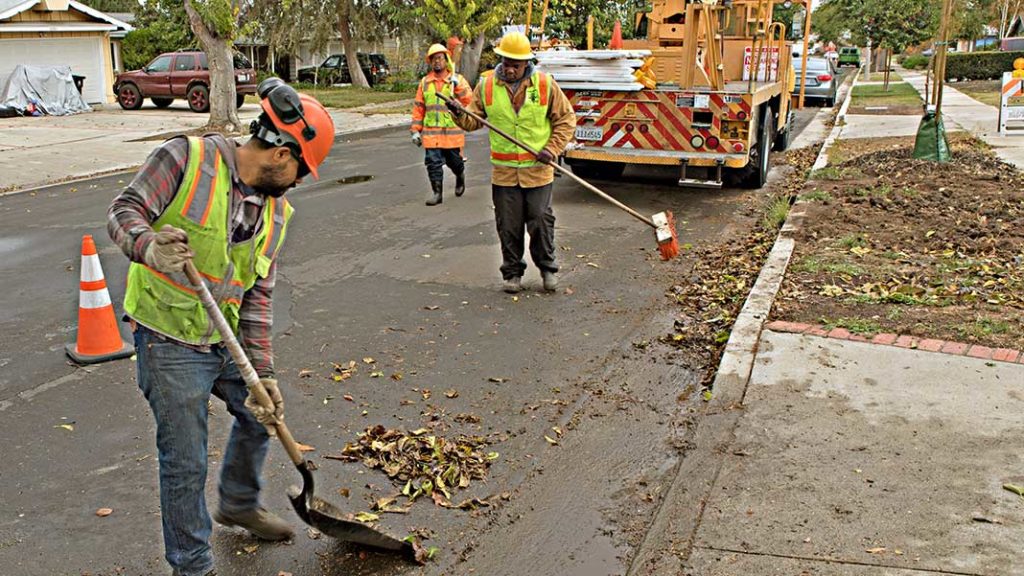
5] Cleanup is always part of the operation, from left: Samuel Mendoza, Assistant Tree Surgeon; and Richard Mitchell, Maintenance Laborer.
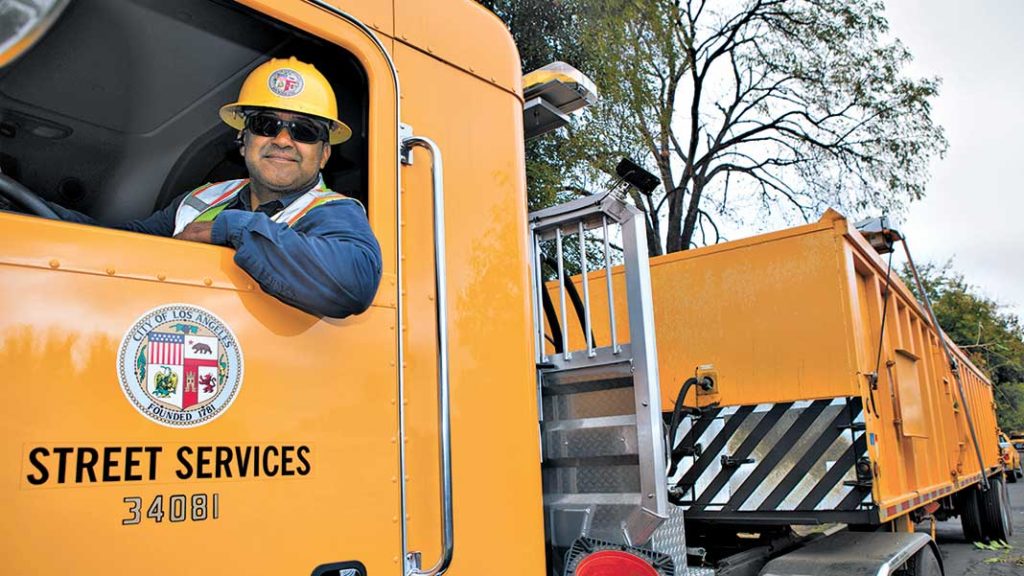
6] No chipper: Because of the size of this tree-trimming operation, Urban Forestry doesn’t use a chipper in this case. It puts all the trimmings into a long truck for mulching offsite. Driving the rig is Elias Becerra, Heavy Duty Truck Operator.



